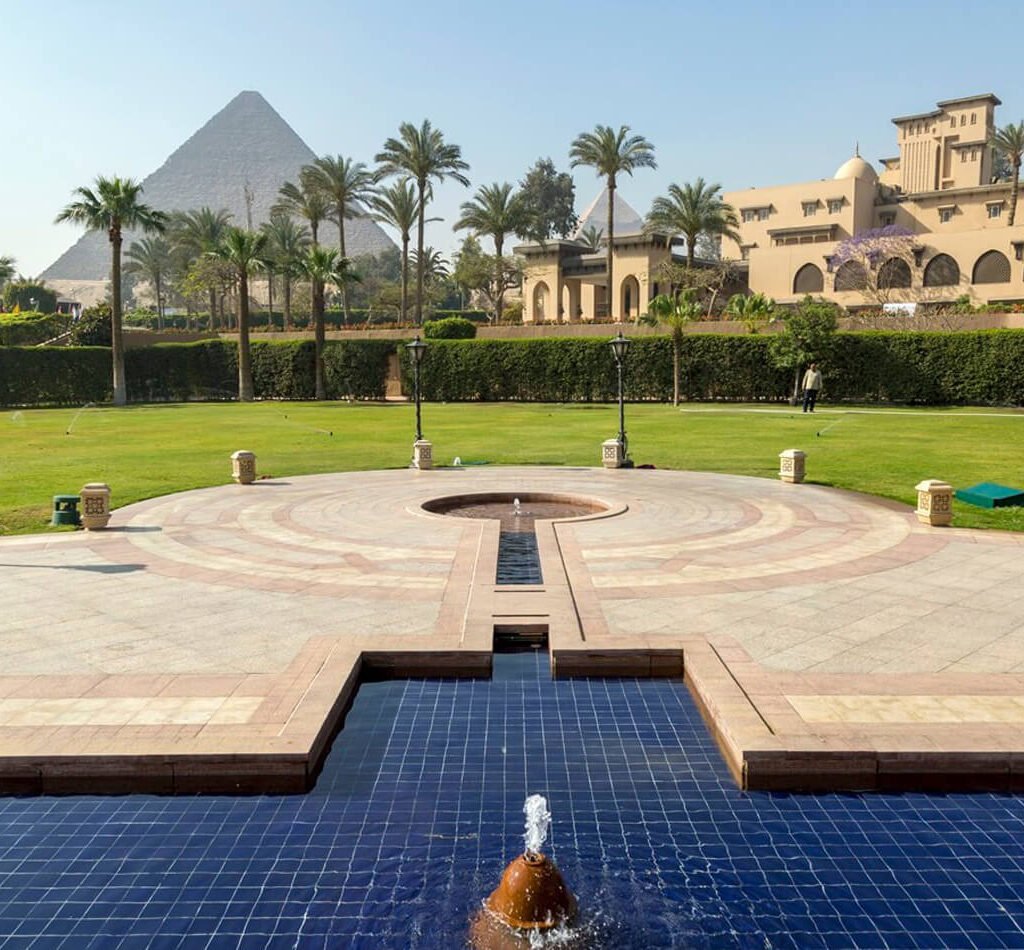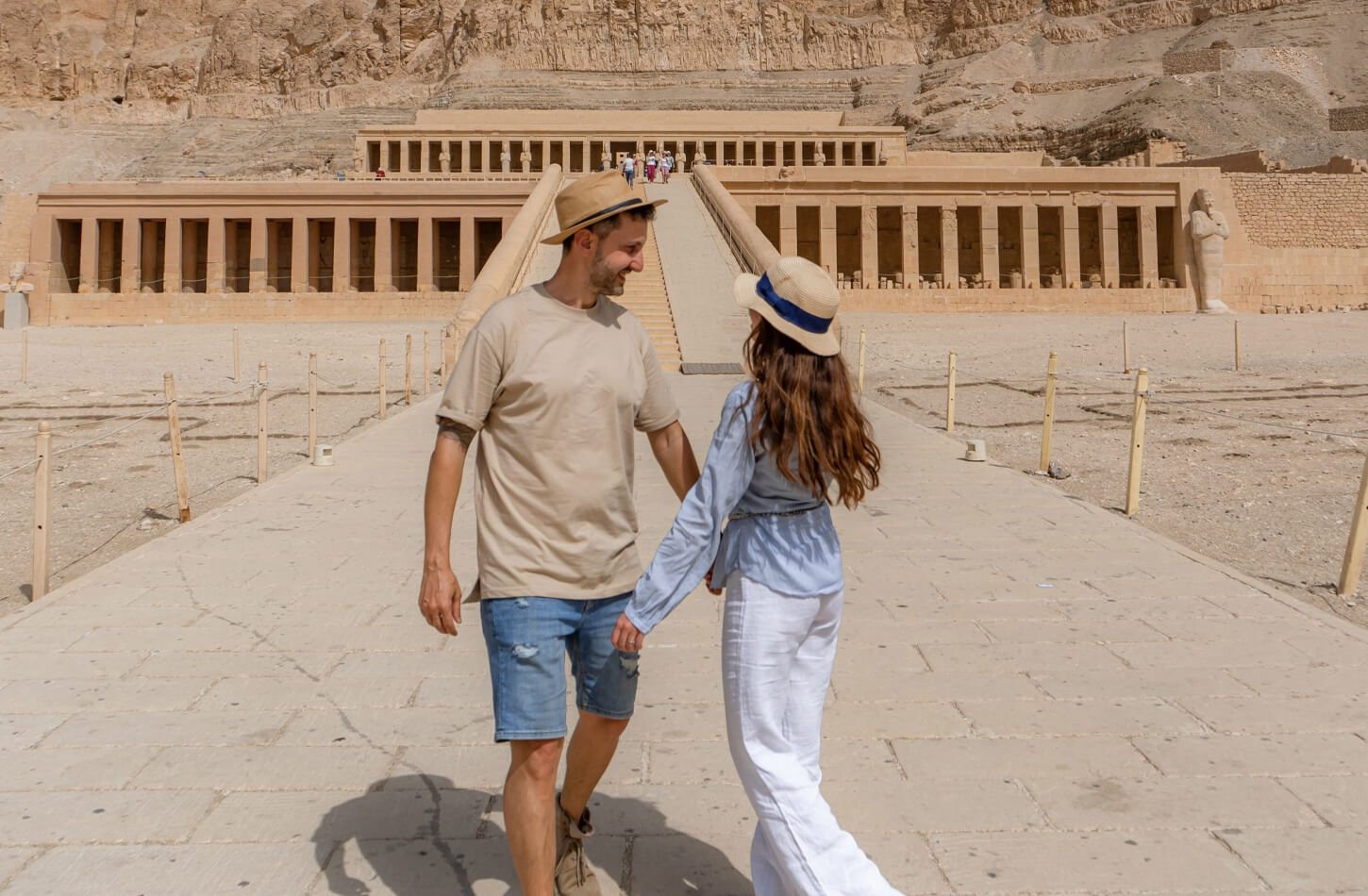
Imagine walking into a grand hallway where Howard Carter searched for King Tut’s tomb. Or sipping tea in a room where Winston Churchill made history-changing decisions. That’s what historical hotels in Egypt offer—they’re not just places to stay, but time machines.
I’ve walked the halls of the Winter Palace in Luxor, where Carter planned his discoveries. Now, I want to share how historical landmarks like Mena House or the Old Cataract Hotel can make your trip unforgettable.
These hotels are not museums—they’re alive. At Mena House, a 150-year-old retreat near the Pyramids, you can wake up to desert views that inspired pharaohs. Or stay at the Sofitel Old Cataract in Aswan, where Agatha Christie wrote *Death on the Nile*.
Every faded wallpaper and creaky floor has a story. Yet, these hotels offer modern comforts like Wi-Fi, spas, and pools. Imagine dining where King Farouq did, then relaxing in a spa suite. That’s the magic of these hotels.
Here’s the best part: you don’t need a time machine. This guide will show you Egypt’s most historic hotels. From colonial-era gems like Alexandria’s Metropole Hotel to Luxor’s Nile-view palaces, rooms start at $100 a night. We’ll help you find hotels near ancient sites and with the best sunset views. Ready to make your trip a story?
Imagine sipping tea in a lounge where Howard Carter once searched for King Tut’s tomb. Egypt’s historical hotels are more than places to sleep. They are windows to the past. The Winter Palace in Luxor, built in 1907, welcomed archaeologists, explorers, and Hollywood directors.
Every corner of these hotels tells stories of discovery and intrigue. Your stay becomes a personal journey through history.
Walk through rooms with creaking wood floors. The scent of aged marble and hand-carved furniture fills the air. At Mena House in Giza, breakfast views of the pyramids are like stepping into a postcard.
These spaces are sensory journeys. Stained glass filters sunlight, and ceiling fans stir air thick with nostalgia.
Location makes these hotels unique. The Sofitel Winter Palace sits on Luxor’s Nile banks, near temple ruins. The Windsor in Cairo is close to the Avenue of Sphinxes, a 3,500-year-old path reopened in 2021.
Unlike generic resorts, these hotels place you in Egypt’s living heritage. Every balcony offers a postcard view of history.

These hotels don’t just house guests. They invite you to live unique vacation experiences. Whether sipping mint tea in a courtyard older than your grandparents’ childhood or tracing walls where legends once stood, you’re not just visiting Egypt—you’re becoming part of its story.
Imagine standing in a hotel that has seen pharaohs, explorers, and many travelers. How do you find the heritage stay that feels like *your* story? Start by matching your curiosity to the era.
Luxor’s East Bank hotels, like those from 1886, show ancient Egypt’s grandeur. The Steigenberger Nile Palace ($120/night) mixes Ottoman details with modern comforts. West Bank hotels near the Valley of the Kings offer a unique backdrop. But East Bank hotels, like the Sonesta St. George ($100/night), are closer to Karnak’s columns.
Comfort is also key. Do you want a 400-year-old bathroom or a spa with Nile views? Many heritage stays offer both. Think hand-painted ceilings in the lobby and modern bathrooms. Even budget-friendly options like the Sonesta combine heritage with cozy rooms.
Luxury accommodations, like the Sofitel Winter Palace ($200/night), offer opulence without losing history’s charm.
Prices range from $100 to $200/night. Think about what you want. Want a Nile-view balcony? Choose the Hilton Luxor ($180/night). Looking for a deal? Book in the shoulder season (April-October) or visit during the day.
Every heritage stay helps preserve history. Ready to choose your era?
Imagine staying where pharaohs hunted or explorers found ancient treasures. Egypt’s historic hotels are like living timelines, each showing a different time. Mena House, near the Giza Pyramids, was once a royal hunting lodge in the 1860s.
Today, it mixes Middle Eastern and European styles. You can sip tea in a suite where kings relaxed, just by the Sphinx.
The Sofitel Winter Palace in Luxor is a colonial-era gem. It was built in 1886, blending British and Egyptian styles. Its verandas and high ceilings remind you of the Raj era, while hand-painted tiles show local craftsmanship.
Guests like Howard Carter dined here after finding King Tut’s tomb. Walk where history was made.
Alexandria’s Metropole Hotel, opened in 1902, brings back the Belle Époque’s glamour. Its pastel facades and marble halls show European elegance. Yet, it’s close to historical landmarks like the Bibliotheca Alexandrina.
The menu also honors tradition, with Egyptian breakfasts and French pastries.
Each hotel has its own story. The Windsor in Cairo was once Turkish baths, now offering Nile views. Steigenberger Cecil, from WWII, still tells tales of spies and statesmen.
These aren’t just buildings—they’re time capsules. Next time you book, ask: what era will you step into?
Walking through the marble halls of Cairo’s Four Seasons Hotel Nile Plaza, you enter a world where every detail tells a story. These luxury accommodations are more than places to sleep—they’re living museums. Imagine sipping mint tea in a suite once visited by kings, or being welcomed by staff in traditional attire whose families have served there for generations. The mix of heritage and modern comfort here is unparalleled.
At the Ritz-Carlton Sharm El Sheikh, top-rated resorts like this offer private beaches and spa treatments inspired by Pharaonic rituals. It’s the small touches that really stand out: a butler arranging a sunset dinner on your balcony, or a historian showing you hidden archives where guest books hold signatures of explorers past. Even the dining rooms feel like time capsules—the Sofitel Winter Palace Luxor serves breakfast with views of Karnak Temple, while their cocktail lounges once hosted Agatha Christie.
What makes these stays unforgettable isn’t just the gold-framed portraits or velvet drapes. It’s the curated experiences: private boat rides along the Nile at dawn, or a desert dinner under stars, just like 1920s explorers. These hotels turn history into a sensory journey—where every meal, every tour, and every quiet moment by the poolside infinity pool overlooking the pyramids becomes a chapter in your own story.
Imagine stepping into ancient Egyptian charm without leaving your hotel. Egypt’s Historical Hotels in Egypt offer more than just rooms—they’re portals to eras long past. Let’s explore where to find them across the country’s most iconic regions.
In Cairo and Giza, Mena House stands as a timeless landmark. Perched at the base of the Pyramids, its Moorish-inspired architecture blends seamlessly with the desert landscape. Picture sipping tea while the Sphinx watches over you—this is where history becomes your backyard. Nearby, the Cairo Marriott Hotel & Omar Khayyam Casino, once a royal retreat, whispers stories of bygone dynasties.
Head south to Luxor and Aswan, where the Nile’s banks cradle treasures. The Winter Palace in Luxor, founded in 1907, hosted archaeologists like Howard Carter during their Valley of the Kings discoveries. Cross to Aswan, and Sofitel Legend Old Cataract invites you to relive Agatha Christie’s inspiration for *Death on the Nile*. Its syenite stone walls and river views make every sunset a tribute to ancient craftsmanship.
Alexandria’s Mediterranean flair shines at the Metropole Hotel. Built in the early 1900s, its Belle Époque style mirrors the city’s cosmopolitan past. Wander its halls and you’ll feel the echoes of its golden age—when traders and scholars shaped Egypt’s global connections. Each region’s hotels tie you to different layers of history, from pyramids to colonial elegance.
Need practical choices? Mena House starts at $18 a night, while Sofitel Old Cataract offers Nile-view rooms from $170. Compare these prices to the Winter Palace’s $100 base rate and decide where your journey begins. Whether you crave pyramids on your doorstep or a front-row seat to temple sunrises, these stays promise authenticity you can’t find elsewhere.
Choosing a heritage stay is more than a vacation. It’s a choice for cultural preservation. Every night in Egypt’s historic hotels helps save buildings from decay. I’ve seen ancient walls get a new life: faded frescoes restored, crumbling plasterwork fixed.
The Winter Palace in Luxor and Tulip Hotel in Aswan are now standing thanks to careful restoration. Experts spend months uncovering original details. They make sure each room tells a story without losing its essence.
These heritage stays also keep traditions alive. Local artisans make furniture using old techniques. You might even learn to paint henna patterns or play a simsimiya lute. By staying here, you support jobs and preserve skills that could disappear.
The Egyptian Ministry’s 2018 reforms now protect history and community well-being. Modern needs and ancient structures can live together. Hidden solar panels power Winter Palace’s pools without ruining its look.
Climate control systems blend into walls, keeping rooms comfy while saving the architecture. This balance is hard but crucial. When you choose heritage lodging, you support innovations that respect the past and look to the future.
Now, over 40% of global travelers seek cultural experiences. Your choice is important. By staying in a heritage property, you help protect UNESCO sites like Georgetown’s six historic hotels. These places are more than places to stay; they’re living museums where every restored column or workshop ensures Egypt’s legacy lives on.
Your visit becomes part of that story, linking your journey to the preservation of timeless beauty.
Walking through Egypt’s top-rated resorts feels like stepping into a history book. My stays at places like the Mena House Hotel and the Old Cataract showed me how to make the most of my time. Start by asking staff about hidden spots, like the suite where Agatha Christie wrote Death on the Nile at the Old Cataract.

Many hotels offer guided tours led by storytellers. They share stories of Empress Eugenie’s 1869 visit and Winston Churchill’s wartime plans.
Golden hour is perfect for photos. Take pictures of the Mena House’s ancient olive groves at sunset or the Winter Palace’s grand staircase. Pro tip: ask for a room with Nile views at the Cairo Marriott—it’s where Empress Eugenie once danced.
Respect the architecture by not using flash in historic rooms. But feel free to take photos where guests like Frank Sinatra once were.
Experience more than just sight. Enjoy meals in dining rooms with menus named after pharaohs. At the Old Cataract, their afternoon tea dates back to 1899—try it with a view of the Nubian desert. Always check the dress code: some places require collared shirts, while others are more casual.
These historic places come alive when visitors connect with their stories. Whether tracing Churchill’s steps or taking a selfie by a 1920s chandelier, every moment links you to Egypt’s past. The best stays are about becoming part of history, not just sleeping in a bed.
Planning your stay in Egypt’s historic hotels is easy. Start by choosing the right time: luxury accommodations like the Old Cataract Hotel in Aswan are best from October to April. This is when the weather is perfect for exploring historical architecture sites.
In Cairo, hotels like the Four Seasons Nile Plaza are comfortable all year. But they get booked fast in winter. So, book 6–12 months in advance for December–February.
When booking, ask about accessibility. Some old hotels might have stairs or uneven floors. Ask if they can plan your visit to avoid crowds at places like Luxor’s Karnak Temple.
Request suites with unique features like arched windows or carved woodwork. These make your stay unforgettable.
Shoulder seasons (April–May or September–October) have better rates without losing quality. Tell the hotel you want to immerse yourself in culture. They might arrange private tours or after-hours access to sites like the Valley of the Kings.
Always check visa costs ($25 USD for a 30-day visa) and pack essentials like sturdy shoes for temple hikes.
When choosing luxury accommodations, look for 24/7 concierge service. They can book sunrise hot-air balloon rides over Luxor or sunset cruises along the Nile. Also, ask about seasonal promotions. Many hotels offer discounts during Ramadan for a unique cultural experience.
Trust your gut when booking. If a hotel’s website lacks photos or details, look elsewhere. The right property will excite you with its history and modern comforts. Your Egyptian adventure begins with a smart booking!
Imagine sipping tea on a balcony where Agatha Christie once found inspiration. Or watch the pyramids glow at sunset from your hotel terrace. Egypt’s historical hotels are more than just places to stay. They are gateways to stories etched into every stone.
The Winter Palace, where Howard Carter celebrated the discovery of King Tut’s tomb, is one such place. Mena House, steps from the Giza Plateau, is another. These hotels offer modern luxuries like spa treatments and Wi-Fi, alongside the whispers of pharaohs and explorers.
Planning your journey? Picture the Egyptian Museum’s golden treasures or the preserved grandeur of Abu Simbel’s temples. These landmarks become your backdrop, whether you’re on a Nile cruise or celebrating New Year’s Eve in Cairo. Let specialists help craft itineraries that balance discovery with relaxation.
Every suite at Le Riad Hotel or every meal included in your tour package adds depth to your story. These hotels aren’t just rooms; they’re stages where your story unfolds. The next time you sit in a courtyard where kings once stood, you become part of Egypt’s timeless tale.
The golden mask of Tutankhamun might line museum halls, but your memory of sipping mint tea at the edge of the Sahara will linger longer. History here isn’t static—it’s a living thread, and your visit threads your own moments into its fabric. So why wait? Pack curiosity and comfort, and let Egypt’s past welcome you home.
Read more related articles:







Don't just get there, get there in style.
Information
Follow Us
Payment channels
